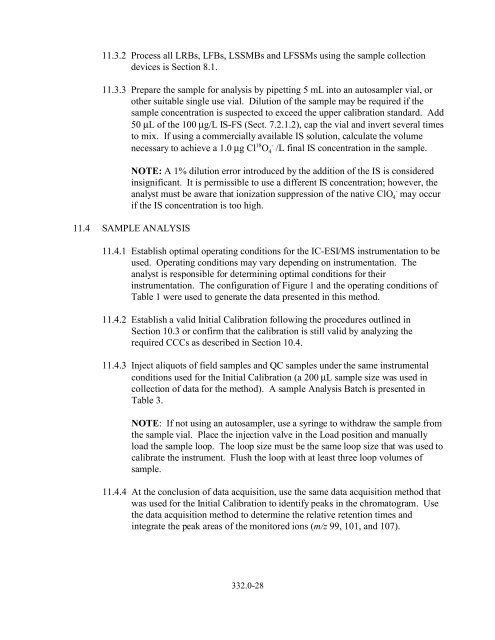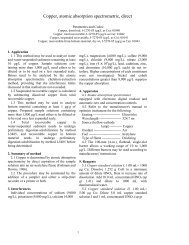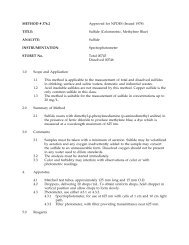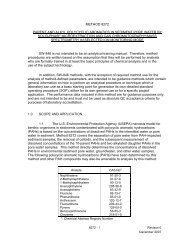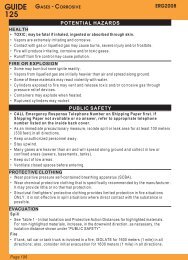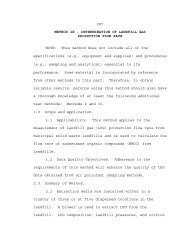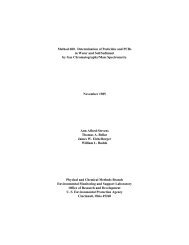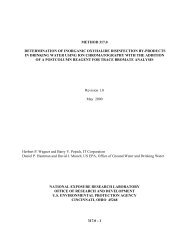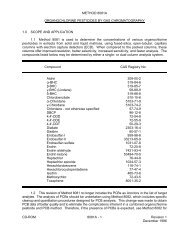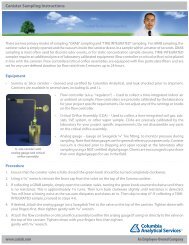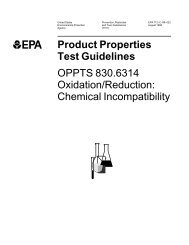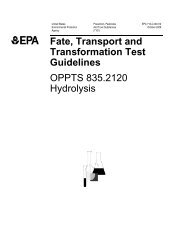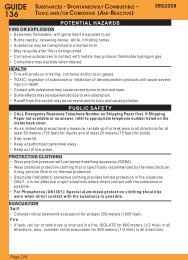View Actual EPA Method 332 (PDF File) - Columbia Analytical ...
View Actual EPA Method 332 (PDF File) - Columbia Analytical ...
View Actual EPA Method 332 (PDF File) - Columbia Analytical ...
Create successful ePaper yourself
Turn your PDF publications into a flip-book with our unique Google optimized e-Paper software.
11.3.2 Process all LRBs, LFBs, LSSMBs and LFSSMs using the sample collection<br />
devices is Section 8.1.<br />
11.3.3 Prepare the sample for analysis by pipetting 5 mL into an autosampler vial, or<br />
other suitable single use vial. Dilution of the sample may be required if the<br />
sample concentration is suspected to exceed the upper calibration standard. Add<br />
50 µL of the 100 µg/L IS-FS (Sect. 7.2.1.2), cap the vial and invert several times<br />
to mix. If using a commercially available IS solution, calculate the volume<br />
necessary to achieve a 1.0 µg Cl 18 O 4<br />
-<br />
/L final IS concentration in the sample.<br />
NOTE: A 1% dilution error introduced by the addition of the IS is considered<br />
insignificant. It is permissible to use a different IS concentration; however, the<br />
analyst must be aware that ionization suppression of the native ClO 4<br />
-<br />
may occur<br />
if the IS concentration is too high.<br />
11.4 SAMPLE ANALYSIS<br />
11.4.1 Establish optimal operating conditions for the IC-ESI/MS instrumentation to be<br />
used. Operating conditions may vary depending on instrumentation. The<br />
analyst is responsible for determining optimal conditions for their<br />
instrumentation. The configuration of Figure 1 and the operating conditions of<br />
Table 1 were used to generate the data presented in this method.<br />
11.4.2 Establish a valid Initial Calibration following the procedures outlined in<br />
Section 10.3 or confirm that the calibration is still valid by analyzing the<br />
required CCCs as described in Section 10.4.<br />
11.4.3 Inject aliquots of field samples and QC samples under the same instrumental<br />
conditions used for the Initial Calibration (a 200 µL sample size was used in<br />
collection of data for the method). A sample Analysis Batch is presented in<br />
Table 3.<br />
NOTE: If not using an autosampler, use a syringe to withdraw the sample from<br />
the sample vial. Place the injection valve in the Load position and manually<br />
load the sample loop. The loop size must be the same loop size that was used to<br />
calibrate the instrument. Flush the loop with at least three loop volumes of<br />
sample.<br />
11.4.4 At the conclusion of data acquisition, use the same data acquisition method that<br />
was used for the Initial Calibration to identify peaks in the chromatogram. Use<br />
the data acquisition method to determine the relative retention times and<br />
integrate the peak areas of the monitored ions (m/z 99, 101, and 107).<br />
<strong>332</strong>.0-28


